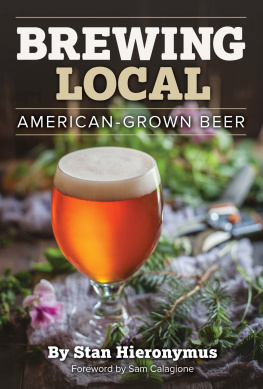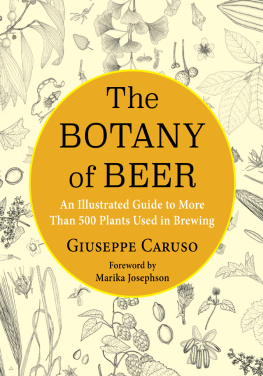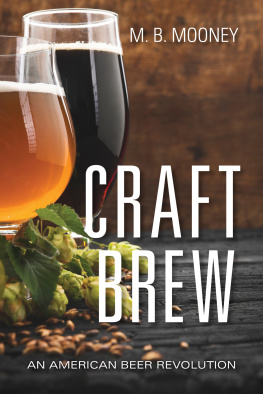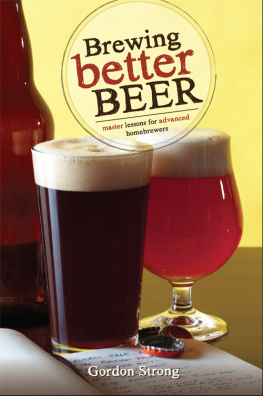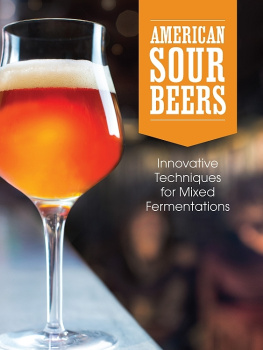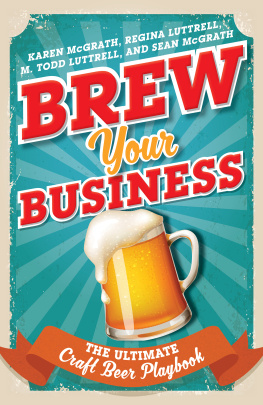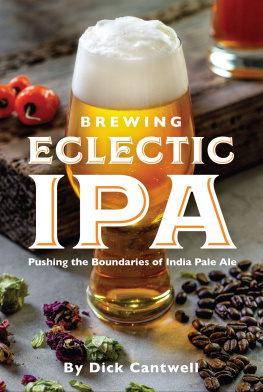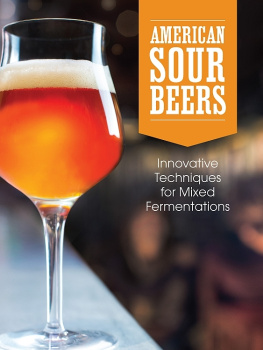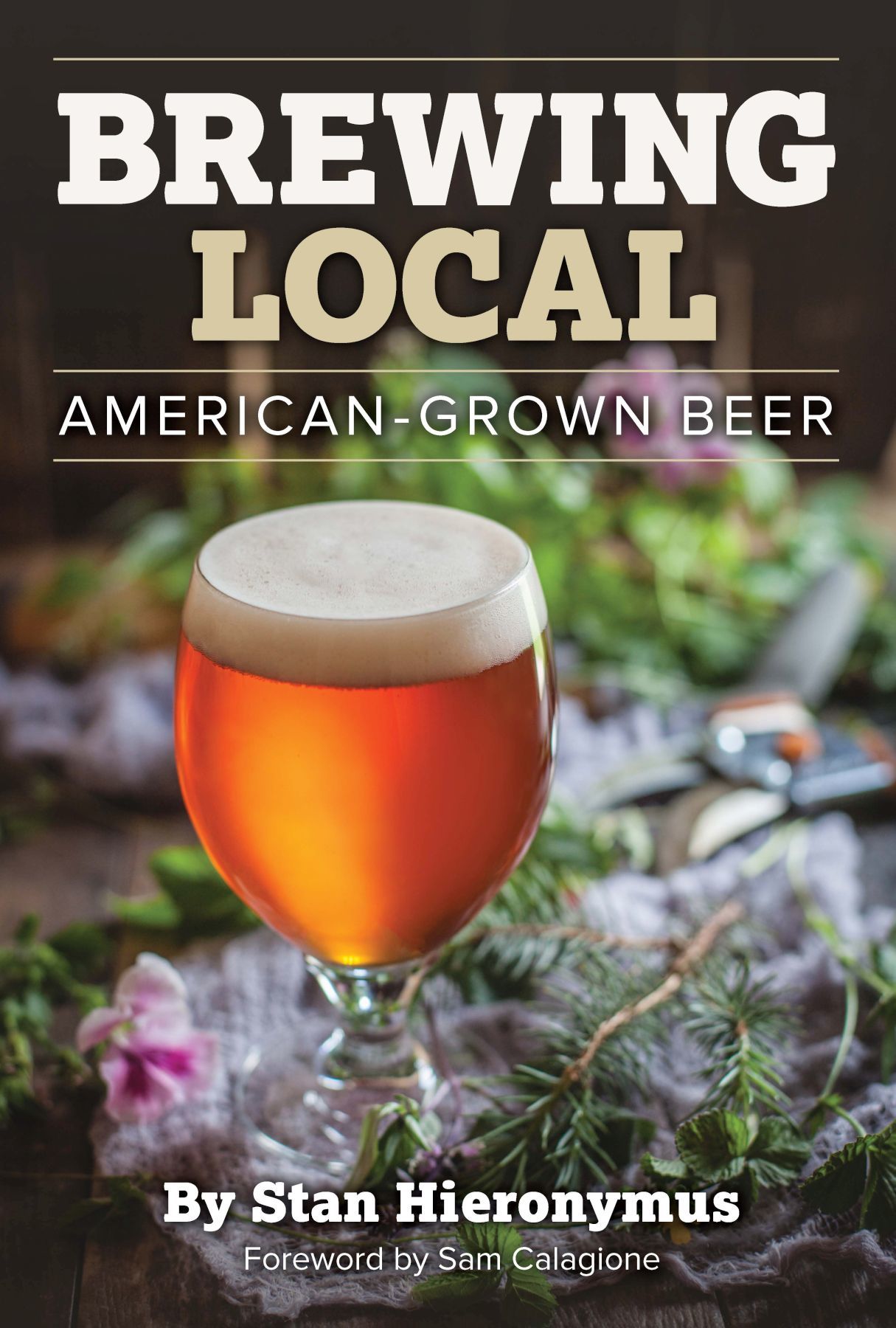BREWING LOCAL
AMERICAN-GROWN BEER
Explore Local Flavor Using Cultivated and Foraged Ingredients
By Stan Hieronymus

brewers publications
A Division of the Brewers Association
PO Box 1679, Boulder, Colorado 80306-1679
BrewersAssociation.org
BrewersPublications.com
Copyright 2016 by Brewers Association
All rights reserved. No portion of this book may be reproduced in any form without written permission of the publisher. Neither the authors, editors, nor the publisher assume any responsibility for the use or misuse of information contained in this book.
ISBN-13: 978-1-938469-27-5
Library of Congress Cataloging-in-Publication Data
Names: Hieronymus, Stan, author.
Title: Brewing local : American-grown beer / by Stan Hieronymus.
Description: Boulder, Colorado : Brewers Publications, a division of the Brewers Association, [2016] | Includes bibliographical references.
Identifiers: LCCN 2016022746 (print) | LCCN 2016032153 (ebook) | ISBN 9781938469275 (pbk.) | ISBN 1938469275 | ISBN 9781938469374 (eBook)
Subjects: LCSH: BeerUnited States. | Flavored alcoholic beveragesUnited States. | BrewersUnited States.
Classification: LCC TP577.H547 2016 (print) | LCC TP577 (ebook) | DDC 663/.420973dc23
LC record available at https://lccn.loc.gov/2016022746
Publisher: Kristi Switzer
Technical Editor: Jason Perkins, Mark Merriwether Vorderbruggen
Copyediting: Christina Echols
Indexing: Doug Easton
Production and Design Management: Stephanie Johnson Martin and Jason Smith
Cover Design: Kerry Fannon
Production: Justin Petersen
Interior Images: Stan Hieronymus
Cover Photography: Kerry Fannon
Interior Illustrations: From the public domain. Source: commons.wikimedia.org
For my wife, Daria Labinsky, the first and still the most popular beer writer in our family.
Table of Contents
I have had the good fortune, in writing four books for Brewers Publications, to have people smarter than I tell me something that provided focus for each book. For Brew Like a Monk it was Hedwig Neven, brewing director at Duvel Moortgat, explaining the importance of digestibility to the beers such as his own Duvel or the ones brewed in monasteries. The book you have in your hands would not be the one it is were it not for conversations with Caleb Levar in Minnesota, Aaron Kleidon at Scratch Brewing, and Mark Jilg at Craftsman Brewing. Were I to try to condense what I took from the three into in one sentence, it would be: Everything is everywhere, you can make it somehow better in the simplest of ways, and we shouldnt be afraid to talk about the importance of a brewers intent.
Brewers understand that they make wort and yeast makes the beer. I hope that everybody at Brewers Publications and the people whose names should be in bigger type than they are at the bottom of the second page understand I consider it the highest compliment to say they perform the same magic as yeast. Publisher Kristi Switzer found a vision for this book before I did and patiently waited for me to catch up. Also, thanks to Mark Merriwether Vorderbruggen, author of Idiots Guide: Foraging, and Jason Perkins at Allagash Brewing Co. for their technical expertise; to Christina Echols for fine-tuning my words; and to Kerry Fannon for the design and Justin Petersen for the actual production.
In addition, special thanks to Sam Calagione for a foreword that captures the spirit of what so many brewers are doing with ingredients somehow known both as traditional and nontraditional.
More thanks to Greg Casey, who shared much of the research he did on his own book, Americans Drink Beer with Their Eyes, likely available in 2017. It will be the most extensive investigation ever into the role adjuncts played in American brewing history, and Ill be the first in line to buy it. A few others who went above and beyond include Conrad Selle, Jace Marti, Dave Berg, Randy Mosher, Nathan Zeender, Marika Jospehson, Ryan Tockstein, and Ann George at Hop Growers of America.
As always, none of this would happen without the support of my family, Daria and Sierra, who for some reason never say no when I suggest something like I need to drive down to Krebs, Oklahoma this weekend. I also fully understand that books like this would not exist if nobody were there to buy them, so thank you.
Mildred: Hey Johnny, what are you rebelling against?
Johnny: Whadda you got?
T his famous exchange with Marlon Brando as Johnny in the movie The Wild One is a great starting point for a discussion of brewing locally in America at this moment in time. Americans are blissfully rebellious in nature. It is awesome to see so many American brewers (pro and home) brewing outside the box in 2016, the 500th anniversary of the German purity law, the Reinheitsgebot.
The pilgrims who settled the Plymouth Colony in the northeast United States, like ancient brewers around the world, brewed beer with whatever beautiful, natural ingredients they could find that came from the earth. They tasted lovely, fermented miraculously, and made them feel closer to their gods and ancestors. Today its no different. The rise of small breweries we are currently enjoying here in the United States is often called a revolution by the media. Thats inaccurate. Its a Renaissance, not a revolution. Prior to Prohibition, there were over 4,000 indie, artisanal, small-scale breweries making distinct regional beers in this country. For everything you have heard about the rise of craft beer in the last four decades as a nation, it took us until 2015 for the number of independent, commercial breweries in this country to eclipse the national high set prior to Prohibition. This is a return to form. The indie craft brewing Renaissance is on. The Reinheitsgebot has been righteously marginalized by todays intrepid and adventurous homebrewers and craft brewers. This Renaissance is a sort of pilgrimage as well. A return to our early-American brewing roots. (Sometimes literally brewing WITH roots). And to borrow a line from R.E.M., the pilgrimage has gained momentum. There is a more specific and (I may be biased) more amazing craft micro-Renaissance happening within the greater craft Renaissance today. As the reader of Brewing Local: American-Grown Beer will soon discover, Stan has done a wonderful job digging beneath the surface, rooting through the history, and foraging the fruitful forests of todays most adventurous American breweries to bring this micro-Renaissance to light. The Renaissance within the Renaissance is the one where we as intrepid home and craft brewers are bringing back brewing ingredients beyond water, hops, yeast, and barley.
All the stereotypes of postcolonial America are tied up in this story that Stan tells so well. Americans are fearless. We relish opportunities to express our ingenuity. And I think this trait has been amplified in our DNA from generation to generation. Perhaps our colonial brewing ancestors made beer with parsnips and mushrooms, corn and fruit, because they had to. Perhaps they made it with those ingredients because they damn well wanted to, and if you dont like it dont tread on me.
Many of us who are students of the American brewing story know the story from the journal of a Mayflower passenger. A strong argument can be made that the settlement in Plymouth was founded on our thirst for beer. Upon setting up camp, our colonial brewing ancestors learned they would need to apply their faith in human ingenuity if they were going to slake their thirst for beer. High-grade, well-malted brewers barley wasnt exactly growing on trees here in the New World. So they began to forage for fermentable sugar sources, for herbs and spices, that they could throw into pots to make their beer.

